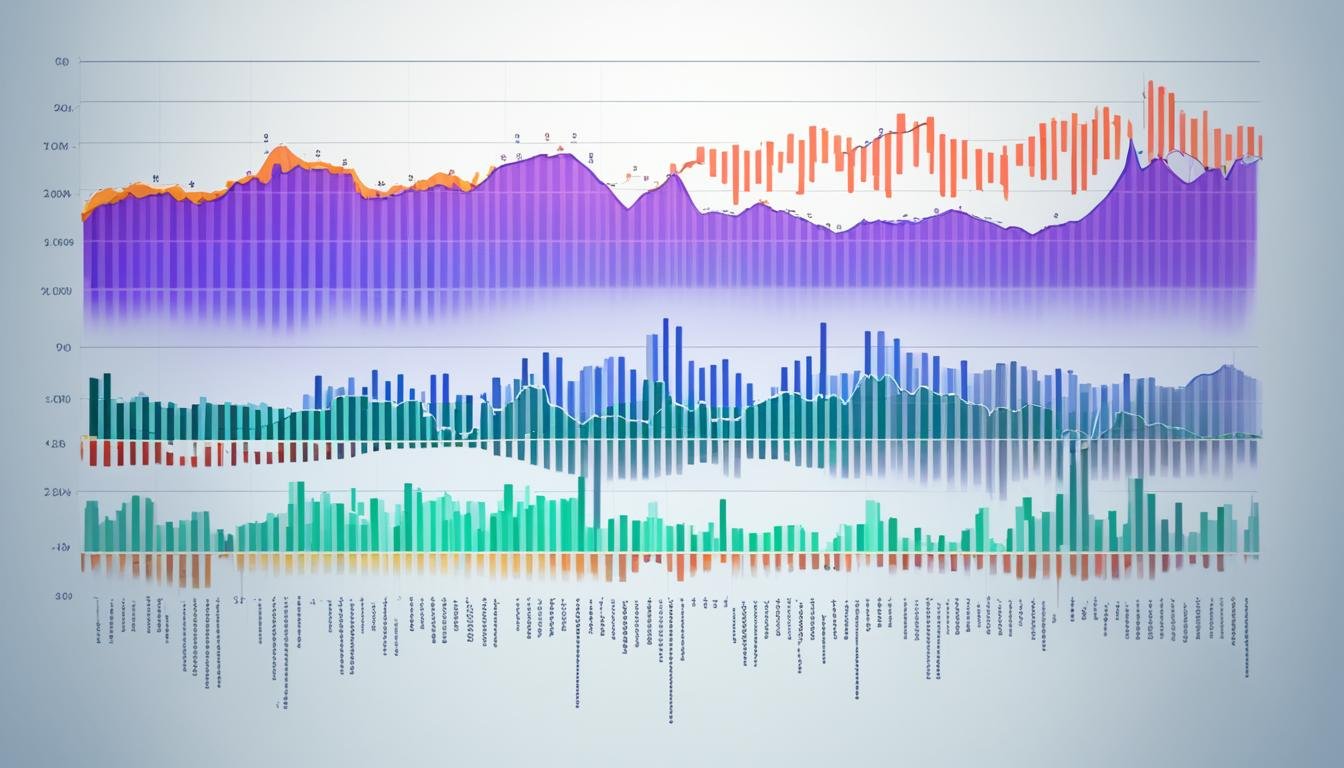Risk Management in Cryptocurrency Trading: A Guide for Finance Professionals
Did you know the cryptocurrency market was worth over $2 trillion in 2021? It’s growing fast and catching the eye of both investors and finance pros. This guide focuses on the basics of trading digital currencies. We’ll show how analyzing financial markets can help reduce risks.
Our aim is to teach finance experts how to handle the ups and downs of crypto markets. With the right knowledge and tools, they can excel in this dynamic field.
Key Takeaways
- Understanding the importance of risk management in cryptocurrency trading.
- Acquiring knowledge of cryptocurrency trading fundamentals.
- Recognizing the various types of risks in crypto investment.
- Incorporating financial market analysis for better decision-making.
- Implementing strategies for effective risk management in volatile markets.
Understanding Cryptocurrency Market Volatility
The cryptocurrency market is famous for its big ups and downs. It’s key for finance pros to know what causes these changes. This helps in handling investment risks better and making smart moves in the crypto world.
Factors Influencing Volatility
Many things affect how the crypto market moves, making it lively and hard to predict. Some important factors include:
- Market Sentiment: How investors feel and what people think can quickly change prices.
- News Events: Big announcements, new rules, and tech advances can really shake up the market.
- Liquidity: How easy it is to trade something affects how wild the market gets.
Historical Volatility Patterns
Looking at past data shows some trends we can use to guess what might happen next. Figuring this out includes:
- Looking at previous price shifts to spot patterns.
- Reviewing big market events that caused a lot of change.
- Using measures of volatility to guess at potential future changes.
Strategies to Mitigate Volatility Risks
There are tricks for finance professionals to lower the risks from market swings. These include:
- Diversification: Putting money in different places to lower risk.
- Hedging: Using tricks to protect against losses.
- Recognizing Emotional Biases: Knowing and dealing with your feelings can stop bad moves in a volatile market.
Key Cryptocurrency Investment Risks
When you invest in cryptocurrencies, there are unique risks to face. Knowing these risks helps in making smart investment choices. Let’s look at the main risks you might encounter in cryptocurrency investing.
Market Risk
Market risk means you might lose money if prices drop. It’s key for investors to check this risk closely to reduce losses. The crypto market can change a lot, which can quickly alter the value of your investments.
Liquidity Risk
The chance that an asset is hard to buy or sell quickly is liquidity risk. Cryptocurrency markets differ in how easily you can trade different assets. Knowing this risk helps avoid big losses when trading in markets that are not easily traded in.
Operational Risk
If something goes wrong with processes or controls, that’s operational risk. In cryptocurrencies, managing this risk is vital to protect against tech problems, cyber attacks, or mistakes. Having good risk management plans makes your investment safer.
Here’s a quick look at the discussed risks:
| Risk Type | Description |
|---|---|
| Market Risk | Risk of financial loss due to price fluctuations. |
| Liquidity Risk | Difficulty in buying or selling assets without affecting the price. |
| Operational Risk | Failures in internal processes, systems, or controls. |
Essential Crypto Trading Strategies for Finance Professionals
Finance pros who want to tackle the ever-changing crypto market must know various trading strategies. Each has its own good and bad points, depending on risks and the market’s state. Here are key strategies used widely.
Day Trading
Day traders buy and sell crypto assets in the same day to take advantage of brief market moves. They look at charts and tools to pick the best time to get in and out of trades. Day trading is fast-paced and can offer quick returns. But, it’s challenging and needs a smart strategy to handle risks.
HODLing
HODLing means keeping onto your investments for the long run, even when prices go up and down in the short term. This suits those aiming for long-term growth, believing the value of their coins will rise over time. It’s a more relaxed approach but needs the investor to stay calm through market ups and downs.
Scalping
Scalpers aim to make many small profits by quickly buying and selling on small price changes. They rely on fast market analysis and execute trades in minutes to catch small opportunities. This style demands serious attention to market trends, but it can be tiring due to always monitoring the market.
Finance pros can mix these strategies to improve their trading, making sure the risks they take are worth the rewards.
Crypto Portfolio Diversification Tips
It’s vital to spread your cryptocurrency diversification to lessen risks. By investing in various digital assets, you help safeguard against one asset’s poor performance. Here are some essential rules to follow:
- Balanced Portfolio Creation: Spreading your investments reduces losses when the market shifts.
- Strategic Asset Allocation: Mix different types of cryptos like DeFi, utility tokens, and stablecoins to balance risk and reward.
- Diversify Geographically: Spread investments around the globe to lower geopolitical risk.
Building a balanced portfolio in crypto needs careful strategic asset allocation. Look at each digital asset’s volatility, market cap, and potential. This helps set your portfolio for long-term success and less risk. Remember, diversifying isn’t just for making more money, it’s also protects against surprise market swings.
Here’s a simple model of a diversified crypto portfolio:
| Asset Category | Example Cryptocurrencies | Percentage of Portfolio |
|---|---|---|
| Large-Cap Cryptos | Bitcoin, Ethereum | 50% |
| Mid-Cap Cryptos | Cardano, Polkadot | 30% |
| Small-Cap Cryptos | Chainlink, Aave | 15% |
| Stablecoins | Tether, USDC | 5% |
Using these steps for cryptocurrency diversification, experts can build a strong and lasting investment plan. This strategy is designed for growth and protects against the unpredictable digital asset world.
Regulatory Compliance in Crypto Trading
Following rules in the world of crypto is key for a trading platform to run smoothly. Financial laws change often, meaning traders and investors must keep up. This helps avoid any legal trouble.
Understanding Global Regulations
The rules on crypto trading differ based on where you are. Places like the U.S., Japan, and the European Union set high standards. The U.S. focuses on protecting investors, Japan makes exchanges follow strict customer and anti-money laundering rules.
Compliance Best Practices
Using proper compliance methods is essential. Here are some tips:
- Adhere to KYC and AML regulations: Set up a strong check system to meet global standards.
- Stay Updated with Regulatory Changes: Always review and refine your approach to match new rules.
- Engage Legal Advisors: Talk to lawyers who know about crypto laws for guidance.
- Internal Compliance Audits: Check your own compliance regularly to fix issues quickly.
| Country | Regulatory Body | Primary Focus |
|---|---|---|
| United States | SEC, CFTC | ICOs, Market Integrity |
| Japan | FSA | KYC, AML |
| European Union | ESMA | Operational Transparency |
Knowing and sticking to these global financial rules helps traders in the crypto market. Following these guidelines means less legal trouble. It also makes trading more honest and reliable.
Cybersecurity Measures for Safe Crypto Trading
It’s important to keep cryptocurrency trading safe for finance pros. Strong cryptocurrency cybersecurity can shield your digital assets from fraud. Let’s look into key steps to keep your investments safe.
Securing Digital Wallets
Keeping digital wallet security tight stops others accessing your money. Pick a wallet that’s well-encrypted and has secure ways to back up. Don’t share your private keys and keep your software updated.
Two-Factor Authentication
Two-factor authentication (2FA) makes it tougher for bad guys to get in. It needs two ways to prove it’s you before letting you in. Go for apps for 2FA instead of SMS to be safer.
Recognizing Phishing Scams
Being careful about phishing is key to stopping fraud. Always check the source of messages and avoid strange links. Learn about common tricks to spot and dodge scams.
- Utilize hardware wallets for digital wallet security.
- Enable 2FA on all your crypto accounts.
- Stay informed about the latest phishing schemes and how to avoid them.
These steps make cryptocurrency cybersecurity stronger. This means a safer place to trade and protect your assets.
Importance of Blockchain Technology Understanding
It’s crucial for finance experts to understand blockchain basics for crypto trading. Blockchain is the technology behind all cryptocurrencies, keeping them safe, honest, and quick. Knowing how blockchain functions is key to making smart moves in the burgeoning crypto market.
Basics of Blockchain
Blockchain is like a digital notebook shared by many, recording deals across computers worldwide. It works without a single boss, which keeps it safe from trickery. Each “block” in this digital chain holds transactions, time info, and a unique ID, creating an ultra-secure record.
Finance professionals will see how transactions are checked and double-locked by grasping these blockchain basics. This knowledge is gold for dealing with cryptocurrency markets.
Blockchain in Cryptocurrency
Blockchain does more than power safe money moves, like with Bitcoin and Ethereum. It also lets us build trust in deals through an open, fixed record. And this tech opens doors to smart contracts, DeFi, and other new ways to use money without traditional banks.
Those in finance who get blockchain’s big picture can make better calls on crypto and its related tech. This understanding helps them weigh the merit of various digital currencies and projects.
Analyzing Market Trends for Informed Decisions
Getting the lowdown on cryptocurrency markets needs a detailed look. Using tools and techniques like technical and sentiment analysis helps traders. They can make smarter choices.
They cut down on risk and aim for better profits. By blending trend insights with market forecasting, investors can chart a clearer path. This is through the ups and downs better.
Technical Analysis Tools
Cryptocurrency trend analysis leans heavily on technical tools. With these, traders crunch past data and trends to guess at future market moves. Here’s a look at the key tools:
- Moving Averages: They make a steady trend line out of price data.
- Relative Strength Index (RSI): It looks at price change size to spot extreme buying or selling.
- Bollinger Bands: These show market fluctuation limits based on volatility.
- MACD (Moving Average Convergence Divergence): It hints at trend shifts by tracking several price aspects.
Sentiment Analysis
Assessing trading mood is key when reading trends. Understanding market feelings helps predict where it’s headed. Valuable sentiment analysis methods include:
- Social Media Monitoring: Real-time emotions from Twitter and Reddit offer a quick snapshot.
- News Analysis: Following stories and headlines helps tune into the public’s view and its market sway.
- Trading Volume: Volume changes signal sentiment shifts, aiding in price predictions.
- Community Forums: Joining trader chats can reveal wider feelings.
By meshing these market prediction techniques with solid technical analysis, traders can up their game. This might bring more wins in the cryptocurrency arena.
Risk Management Strategies in Crypto Trading
In crypto trading, managing risks well is key to success. Having a stop-loss plan, using the right trade size, and spreading investments can protect your money. These steps keep your trading balanced and safer.
Stop-Loss Orders
A stop-loss plan is important to avoid big losses. You set a sell order for your asset if it drops to a certain price. This way, you limit how much you can lose and keep a clear head during wild market swings.
Position Sizing
Choosing the right amount of money to put in a trade is crucial. By figuring out the risk of each trade, you can protect your investment. This means no single trade can hurt your whole portfolio too much, which helps it grow steadily.
Asset Allocation
Spreading your investments helps lower the risk. With a varied portfolio, you can reduce the damage of one asset not doing well. Using different types of assets, like crypto, stocks, and bonds, can make your finances more secure over time.
| Strategy | Benefit |
|---|---|
| Stop-Loss Orders | Limits potential losses by predefining exit points |
| Effective Position Sizing | Protects capital by managing the size of each trade |
| Asset Allocation | Diversifies risk across multiple asset classes |
Case Studies of Successful Risk Management
Learning from real-world scenarios can be valuable. This section shows risk management case studies in crypto trading that have been successful. Each study explains the strategies used and the results. They give insight to finance professionals on how to handle investment risks.
Case Study 1
A finance expert used a strong risk management plan in the volatile cryptocurrency market. This approach involved several key steps:
- They used stop-loss orders to limit losses.
- They spread their risks through diversified asset allocation.
- For making decisions, they used technical analysis tools.
This method led to impressive outcomes. The trader lowered their risk in tough market situations and saw big profits.
Case Study 2
The second case involves different risk strategies that also brought success. This trader used:
- They managed their losses through position sizing.
- They had a solid trading plan rooted in deep market analysis.
- They adapted to market shifts through portfolio rebalancing.
By combining these tactics, the trader achieved consistent growth. It shows the power of blending different risk management methods.
Looking at multiple case studies shows how diverse risk management can be in crypto trading. There is a table below that gives an overview of the strategies used and the results of each case.
| Case Study | Strategies Used | Challenges Faced | Results Achieved |
|---|---|---|---|
| Case Study 1 |
|
Market Volatility | Reduced losses, maximized returns |
| Case Study 2 |
|
Market Fluctuations | Steady growth, effective risk management |
These case studies offer helpful examples for crypto traders. They aim to help improve their risk management tactics and thrive in the cryptocurrency market.
Risk Management in Cryptocurrency Trading: A Guide for Finance Professionals
Cryptocurrency trading is about handling risk smartly. This cryptocurrency trading guide gives important tips for dealing with the ups and downs of crypto markets. By using strong risk management, you can protect your money and aim for bigger profits. Learning and applying these methods is key for anyone in finance wanting to succeed in this fast-changing area.
It’s crucial to understand and reduce market risks. Learning about liquidity and operational risks is vital in trader education. Also, it’s important to meet rules and secure your trading online. Careful study and using smart strategies are vital.
Below is a table showing how to manage various risks:
| Key Element | Risk Management Strategy |
|---|---|
| Market Risk | Diversify investments and use stop-loss orders |
| Liquidity Risk | Trade in high-volume assets and monitor market fluctuations |
| Operational Risk | Implement secure digital wallets and two-factor authentication |
| Regulatory Compliance | Stay updated on global regulations and adopt best practices |
| Cybersecurity Measures | Regularly update software and educate on phishing scams |
Risk management is crucial for successful cryptocurrency trading. By keeping up with learning and using strong advice, finance pros can handle risks well. This leads to better trading results over time.
Conclusion
Wrapping up this guide on cryptocurrency risk management is crucial. This is especially for finance pros who want to stay safe in the digital currency world. Volatility is a big deal, so a strong plan with preventive and reactive steps is vital. Stop-loss orders and smart position and asset management can help lessen risks.
Investing wisely involves looking at risks, market changes, and protecting against cyber threats. Finance pros need to keep learning about new tech, ways to do things, and rules. Knowing the blockchain and watching market movements are key parts of good risk management.
Undoubtedly, keeping an eye on risks in cryptocurrency trading is a never-ending job. Laws and the trading atmosphere change a lot. It’s important for finance pros to stay alert and take actions in time. By sticking to these ideas, they can handle the challenges of trading crypto with more confidence. This way, they can aim for lasting success in their money moves.








